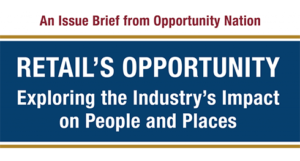Opportunity Nation’s latest report, Retail’s Opportunity, analyzes the industry’s impact on opportunity
 •
•
Opportunity Nation’s latest report, Retail’s Opportunity: Exploring the Industry’s Impact on People and Places uses data from the Bureau of Labor Statistics and Opportunity Nation’s Opportunity Index, among other sources, to analyze the industry’s impact on people, career paths, and community quality of life measures.
The centerpiece of the report is an analysis of correlations between the retail industry and the Opportunity Index — Opportunity Nation’s annual composite measure at the state and county levels of economic, educational, and civic factors that expand opportunity. The research also explored analysis of the skills and experience that typically help retail workers advance within the industry. This research aimed to understand where retail workers come from and where they go in their careers, and drew upon a database of 49 million resumes from CareerBuilder.com.
“As the largest private-sector employer in our nation today, the retail industry holds an unrivaled position of influence to expand economic opportunity for millions of American workers, particularly for young adults seeking their first job,” said Monique Rizer, executive director of Opportunity Nation.
“Nearly one quarter of people working in retail are young adults under the age of 25—affirming the sector’s role as a great place to enter the workplace as well as the importance of understanding how the sector can create career pathways for individuals seeking their first job, or a long-term career in the field. We’re excited to share this important research and help lead our coalition’s discussion on ways the retail industry can create and improve pathways of opportunity for all.”
The research found a positive relationship between a state’s Opportunity Index Score and state retail employment rates, meaning that as retail employment rates increased, state’s Opportunity Index Scores also increased.
Most significantly, the research found higher retail employment rates to be associated with economic, education, and community variables from the Opportunity Index.
Other key findings include:
- Increases in retail employment rates correlated with lower crime rates, lower poverty rates, lower income inequality, and higher on-time high school graduation rates.
- It is quite common for retail workers to attend school while working. Forty percent of those analyzed held retail jobs while completing their education or added education after their first retail position.
- Although men hold a majority of managerial roles, most retail jobs are still dominated by women and a quarter of workers employed in retail are under age 25.
- Wages across retail occupations vary widely based on experience and skills. While starting pay is often low, many retail workers earn much more than the median wage as they gain experience. Competitive wage jobs can be found within many of the occupations that are often considered to be low-wage and low-skill. For instance, the top 25 percent of customer service representatives in the research earned more than $19.36 an hour, while the top quarter of retail team leaders made more than $21.97. For more experienced store managers, median hourly pay topped $47—a solid middle-class job.
- While millions of Americans work in retail, few stay in the same position over multiple job changes. Twenty-five percent of overall retail workers switched to another position when moving from their first job to their next one. For example, 26 percent of cashiers and 27 percent of salespersons moved to office and administrative support jobs directly from their first job in retail.
- Retail workers who move up the ranks into management and supervisory positions do so in a variety of ways. The research showed that one quarter of store managers came directly from lower-level sales jobs and related positions, but half came from other management-level posts, and moved laterally to their new spot in a different company.
- Retail workers at all levels tend to move laterally within the industry but also beyond it—coming and going between a wide variety of positions ranging from retail to office jobs to manufacturing.
The research was conducted in collaboration with Measure of America and Emsi and funded by the Walmart Foundation.
The report also suggests strategies that can help advance career pathways and greater economic opportunity in the retail sector, from public policy changes to business-led initiatives.
To download the report, visit our retail report page.









